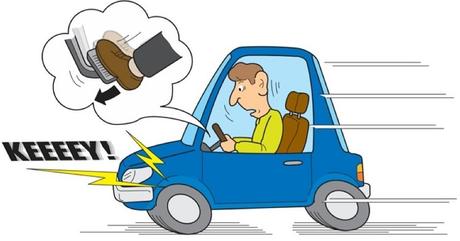
When the car pulls to the right when braking, this problem points to something involving either, the front tires, front end, or front brakes. The rear tires, rear end, and rear brakes aren't really the factor here. Why? because the front ends/ front tires control the steering while the front brakes do most about 75% of the braking. Let's try to determine what's wrong.
Go out to your car and look at the front tires. Try to determine if one has more air than the other. You can either use a tire pressure gauge or just visually inspect the bulging at the bottom of each tire and compare them that way. As you've probably guessed, unevenly inflated front tires will cause a vehicle to pull to one side. This pulling is most noticeable when braking.
How to Check Tire Air Pressure
The tire tread life will be reduced if the tire air pressure of your car is below the car manufacturer tire air pressure specified on your car owner’s manual.Learn more: How to Check Tire Air Pressure
If the front tires unevenly inflated. Imbalance tire pressure causing pull. As indicated, the front tires are unevenly inflated. This is causing an imbalance in the front end which is why the vehicle pulls when the brakes are applied. By the way, the vehicle probably also pulls even when the brakes aren't applied. However, when you step on the brakes, the pulling is exaggerated and therefore more noticeable.
What to do?
Add air to the front tire which is low.
However, if the front tires are evenly inflated. Let's move on to the next thing. Well, check the front end alignment by doing a simple road test.
Find a level, straight road with no cars around. As you are driving down this road, slightly relax your grip on the steering wheel for a second and see if your vehicle veers or "wants to pull" to either the right or left. Make sure your foot is not on the brake while doing this test. Why? Because we want to find out if your vehicle pulls when the brakes are not applied.
If the car veer to either right or left. The front end is out of alignment. As we learned, the car pulls to one side even when the brakes are not applied. This means there is a positioning problem among the front end parts. In other words, the front end is "out of alignment".
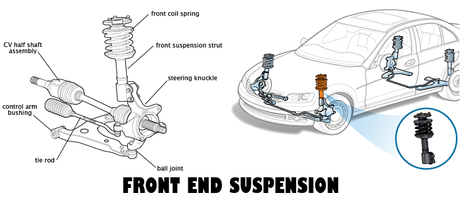
Under this condition, stepping on the brakes causes the pulling to become exaggerated and therefore very noticeable (as we have experienced). It's possible but unlikely that there is also something wrong with the brakes. However, nine times out of ten in a situation like this, the cause of the problem solely lies with the front end (being out of alignment).
What to do?
You will need to have the front end aligned. The mechanic will first do a complete inspection of the front end before doing an alignment job. Don't be surprised if the mechanic recommends replacing one or more bad suspension parts which he "noticed" during his inspection. Although he may be right, get a second opinion if this is what you're hearing. Try to find a repair shop that's either approved by the AAA or at least staffed by a few ASE certified mechanics.
But if the car does not veer to either right or let then a front end related problem cannot be established. Let's check the brake themselves. For this procedure, you will need two jack stands, a jack, and a lug wrench. First, make sure the vehicle is parked on a level surface and that the parking brake is on.
Using the lug wrench, loosen the lug nuts on each of the front tires (if this vehicle has hubcaps, you'll have to remove them to get at the lug nuts). Then, jack up one side of the vehicle, place a jack stand under it, and lower the vehicle onto the jack stand. Repeat this for the other side. After this, the front of the vehicle will be jacked up. Now, remove the front tires (you'll have to finish unscrewing the lug nuts for this) and the brakes will be exposed.
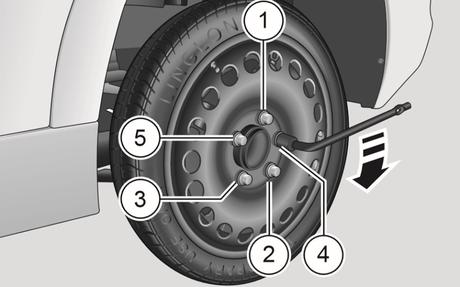
Now, examine the brake discs and look for an oily substance which may be on one of them. You may want to rub your finger across each disc to check for grease or fluid which is not easily visible. However, if this vehicle was driven just before you removed the tires, the discs will be hot. In this case, wait for them to cool before you touch them.
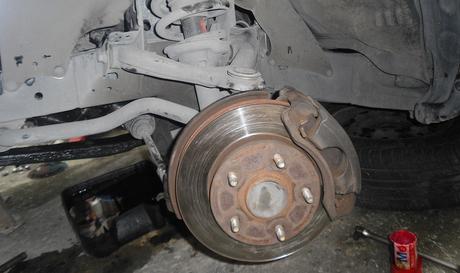
If you notice an oily substance on one of the discs, the contaminated disc is causing brake pull.
Disc brakes can only work if there is great friction between the discs and pads. As you indicated, there is an oily substance on one of the discs. This substance is reducing the friction between the disc and pads for that brake. As a result, that brake is not braking well. Since the other front brake is working (or at least working better), there is uneven braking between the two. With this, a vehicle will pull when the brakes are applied.
What to do?
The oily substance on the disc is probably the result of a leak somewhere. Check the brake caliper and brake line.
The leak may be very slight so please inspect very closely. If you are not able to find anything, take this vehicle to a reputable garage and ask the mechanic to thoroughly check the brakes.
If you did not notice an oily substance on one of the discs let's go to the next thing. Take another close look at the discs but this time check to see if one is thicker than the other. You should actually measure each disc's thickness and compare the two. A micrometer is an ideal tool for this but since we are looking for a significant difference in thickness, a ruler will do.
If one disc was thicker than the other, the mismatch of discs is causing brake pull. For a vehicle not to pull when the brakes are applied, the components of the left brakes must be identical to those of the right brakes. As what is indicated above indicated, one disc is thicker than the other. This will cause the brake pull.
The car will need new, matching discs. New pads are probably not necessary although getting them along with new discs would be ideal.
Have you wonder how is it that one disc is thicker than the other? Since discs are made of very hard metal, they don't really wear out. The only likely answer is that the last time you had brake work done, the mechanic either machined one disc and not the other or replaced one disc and not the other. If this brake pull problem started to occur after you had brake work done, go back to that shop andinquire about this.
If one disc is not thicker than the other. Examine the pads of each brake unit carefully and check to see if one set of pads is thicker than the other set (i.e. the outer pad of one brake -vs- the outer pad of the other brake and, the inner pad of one brake -vs- the inner pad of the other brake). As in the last test, a ruler or any other type of rough measuring device will do since we are looking for a significant difference in thickness.
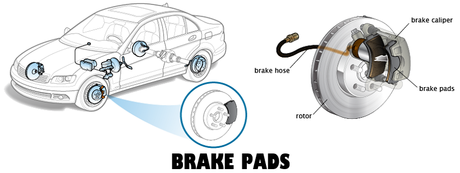
If one set of pads thicker than the other set, the mismatch of pads is causing brake pull. For a vehicle not to pull when the brakes are applied, the components of the left brakes must be identical to those of the right brakes. As indicated above, one set of pads is thicker than the other set. This will cause a brake pull.
What o do?
This car will need a new, matching set of pads. Along with the pads, it probably would be a good idea to have the discs machined so the pads and discs "mate" well together. Now, how is it that one set of pads is thicker than the other set? Earlier, we failed to establish an alignment problem although this would have provided an explanation. So then, the only likely answer is that the last time you had brake work done, the mechanic replaced one set of pads and not the other. If this brake pull problem started to occur after you had brake work done, go back to that shop and inquire about this.
If one set of pads is not thicker than the other set then it is a case of a faulty brake caliper. For a vehicle not to pull when the brakes are applied, the components of the left brakes must work exactly the same as those of the right brakes. Disc brakes have something called a caliper which, when you step on the brake pedal, "squeezes" the pads against the disc. If one of the calipers is not working properly, the braking action between the left and right brakes will be uneven and consequently, the vehicle will pull.
What to do?
Take this vehicle to a reputable shop and ask the mechanic to check the disc brake calipers. One of them could have as ticking piston or be leaking brake fluid.
